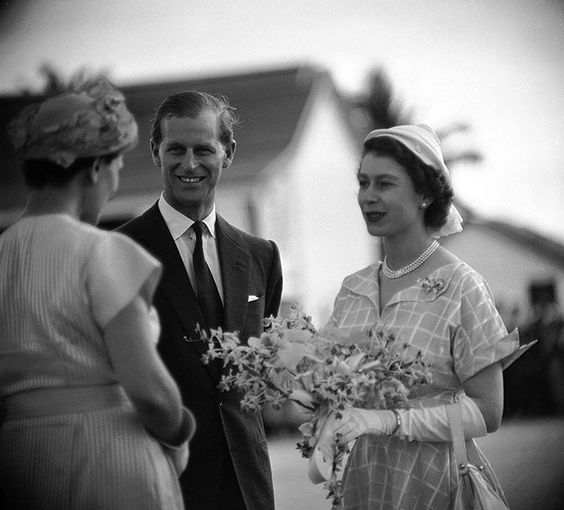 |
| The Queen and The Duke of Edinburgh in Jamaica, 1953. Image from Life. |
Some quarter a million people welcomed Queen Elizabeth II when she and the Duke of Edinburgh visited Jamaica on November 25-27, 1953. The visit was part of the extensive Commonwealth World Tour, which brought the young monarch to far-flung areas of the British Commonwealth in a span of six month and through 43,618 miles. Her first stop was Bermuda, where she embarked on a two-day tour of the then-British colony. On the 25th she and her husband flew to Kingston, the Jamaican capital, where they "immediately won the islanders' hearts by driving 120 miles across the country heedless of the blazing tropical sun," reports New York Times correspondent Sydney Gruson.
After a five-hour flight from Bermuda, Queen Elizabeth II and Prince Philip arrived at Montego Bay airport at exactly 10 in the morning. Representatives and dignitaries greeted the queen and the Duke of Edinburgh as they stepped out from their aircraft. William Alexander Bustamante, chief, and later the first prime minister of Jamaica, presented her a beautiful handprinted "loyal address of most sincere welcome" on behalf of the people of Jamaica.
This address "voiced our dearest wish that we should build a new dominion here in the West Indies to take an honourable place with the other dominions" of the British Commonwealth.
Queen Elizabeth II and the Duke of Edinburgh rested for an hour and a half, which they spent on lunch and a quick plunge on the clear Caribbean waters. They then proceeded on their eight-hour Caribbean road trip until they reached King's House, the official residence of the Governor-General, Sir Hugh Foot. This stately residence set amidst a lush thirty-acre ground, was the royal pair's home for their three-day visit.
Wearing pale blue silk pink dress and a blue pillbox hat, The queen was undaunted by the blazing sun, occasionally using a white silk parasol to protect herself from the heat. The Duke of Edinburgh, meanwhile, wore his white tropical naval uniform and a pair of sunglass to shield his eyes against the glare.
 |
| A stamp featuring an image of The Queen and the coconut palms at Columbus Cove issued in 1953 in commemoration of Her Majesty's visit. |
So popular was the royal pair's visit that about one-sixth of the country's total population turned out to see the queen, cheering the royal party on the route as they drove from Montego Bay, off the island's northern part, down to Kingston. Along the way, they made several stops to about a dozen towns where they received dignitaries. A sincere sense of pride for their head of state enveloped the Jamaicans since this visit was the first-time ever that they had the chance to catch a glimpse of their sovereign. Wherever the royals passed by, thousands of people cheered in unison and not even the scorching heat or the cloudburst dampened the spirit of the Jamaican populace.
Among the scenic routes the queen and the duke passed by included Discovery Bay and Runaway Bay, the latter is where the British defeated the troops of Cristobal de Ysassi, the island's last Spanish governor and ultimately ending a century-and-a-half of Spanish rule. The royal pair was also driven around Saint Ann's Bay, where, in 1503, Christopher Columbus, sought shelter from storms and where he stayed for a year until rescue came. They also passed by New Seville, the ancient capital of the islands.
The royal caravan encountered a heavy downpour halfway through the road trip. At Linstead, the party drove slowly and even the rain did not stop the people from waiting to see their monarch pass by .To protect themselves from the torrent, some tore banana leaves for makeshift hats.
Such was the fervent adoration of the Jamaicans that one member of the queen's party remarked: "It takes a queen to keep Jamaicans in the rain. If it had been anyone else they would have gone home."
The long drive finally ended when they reached Spanish Town, 13 miles from Kingston. For over three centuries, Spanish Town was the island's capital, until it was moved to Kingston in 1872. The queen and the duke received the Custos (Guardian) of the Parish of Saint Catherine, at the foot of the Rodney Memorial, the latter was built in honour of Admiral George Rodney. Admiral Rodney served as commander-in-chief of the West Indian Naval Station in 1782. He led the British troops in Jamaica that defeated a combined French and Spanish invasion during the Battle of the Saints.
Giant triumphal arches, applause and cheers from thousands of Jamaicans welcomed Queen Elizabeth II and the Duke of Edinburgh when they entered Kington. In Sabina Park, they rode an open-top Land Rover where they greeted a crowd of schoolchildren and young Jamaicans who were all giddy to catch a glimpse of the royal couple.
 |
| Queen Elizabeth II and The Duke of Edinburgh at Sabina Park. Getty Images |
One of the highlights of the queen’s 1953 tour of Jamaica was the visit to the Botanical Gardens. She was impressed by the beauty and variety of the botanical collection that she bestowed the designation of “Royal” to Kington’s largest public green space and Jamaica’s most popular collection of endemic and exotic botanical collections.
Described by Life as "a little fagged after four days of royal touring", the queen spoke at University of the West Indies on the lasts day of her stint in the Caribbean before she flew to Fiji.
Watch: Queen Tours Jamaica (1953
Queen Elizabeth II’s Commonwealth Tour of New Zealand and Australia 1953-1954
Watch: Queen Elizabeth II’s World Commonwealth Tour1953-1954


.png)





0 Comments